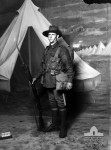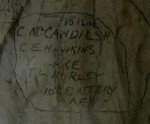HAWKINS, Clarence Edmund
Clarence Hawkins was the son of Alfred George Hawkins, a tailor, and his wife Mary Adele, nee Merson. Born in 1883, he was the second eldest of a large family of five boys and one girl: Theodore (1881); Bertram (1884); Mabel (1886); Raymond (1887): Edgar (1889); Philip (1890) and also had three half siblings Victor (1895) Reginald (1897) and Marjorie (1899). He was born in East Melbourne, but it was probably a reference to a hospital, rather than a home address and by the time he enlisted on 18 August, 1915, his father was living at 155 Tooral Rd., South Yarra.
Private Hawkins was 32 years and three months old when he signed up and was sent for training to Albert Park, where he was attached to the 1st Reinforcements of the 10th Field Artillery Battery, part of the 4th Field Artillery Brigade of three batteries, the 10th , 11th and 12th. He described himself as a labourer, single and belonging to the Church of England. On 12 March, Clarence hawkins was taken on strength with the 4 Field Artillery Brigade and on 18 November, 1915, they left for Egypt on board HMAT Wiltshire, disembarking at Suez on 15 December, 1915, where the men joined the 2nd Division for further training, joining the BEF at Alexandria.
The Gallipoli campaign was over and in March, 1916, the 4 FAB embarked at Alexandria for France, disembarking at Marseilles on 19 March, 1916. From here, they travelled by train to Le Havre, where they picked up thier vehicles and weapons, proceeding on to Armentieres on 8 April. Armentieres, according to the AWM unit history, was a 'nursery sector', out of the main line of battle, 'blooding' the troops for hwat was ahead.
The main action was at the battle of the Somme, to relieve the French at Verdun. The 4 Field Artillery Battery were deployed at Sausage Valley, near Pozieres, in late July, moving on to Ypres, Flanders in September, where they supported the troops at Pozieres and Bapaume.
In March,1917, the 4 FAB was at Bullecourt; in Junbe, they were back ar Flanders, involved in constant action supporting the allied attacks at Messines, Menin Road, Polygon Wood, then Passchendaele, all part of the Third Battle of Ypres. Clarence Hawkins was given a week's leave in August, leaving for England on the fourth, and returning to his battery on 18 August.
On 31 September, Clarence Hawkins was recommended for a Military Medal, following his exemplary courage and dedication to duty at Hannebeeck Valley, near Westhoek:
Driver C.E. Hawkins, with a party of pack animals and other drivers, were caught in a heavy barrage. The driver's two horses were blown into a shell hole and became bogged, the other drivers succeeded in getting their horses away to a flank. Notwithstanding the heavy shell fire, Driver hawkins remained with his bogged horses, cleared them of their saddlery, got them out of the bog and ultimately delivered his ammunition to his Battery, returning afterwards to the shelled area and assisting to extricate the abandoned horses, whose drivers had been wounded.
Clarence Hawkins was awarded the Military Medal on 4 February, 1918, for his actions that day. In March, he was back on the Somme, the Field Artillery Batteries supporting the troops at Peronne, Mt. St. Quentin, Bellicourt and along the Hindenburg Line. He was given leave to Paris on 23 August, returing to the filed on 28 August. There was another spell of leave on 14 September, this time to England, returning on 4 October. The exhausted battalion was retired from action on 18 October and on 11 November, the war came to an end.
The 4th FAB marched into Havre on 26 february, 1919, returning to England the next day. From England, Clarence Hawkins was returned to Australia on board HT Runic leaving England on 27 March and disembarking at melbourne on 10 June, 1919. He was discharged from the army on 2 August 1919, returning to his father's house at 155 Toorak Rd., where he stayed until 1922. In 1923, he married Mary Philomena Scanlan at Murwillumbah, NSW. He died, aged 69, in 1952 at Surry Hills, Sydney, NSW.
The French archaeologist, Gilles Prilaux, has recently contacted us with the information that C E Hawkins was one of nearly 2000 Australian soldiers who scratched their names on the walls of the limestone caves beneath Naours in northern France. This complex of tunnels was originally excavated in the 3rd century as quarries. During the Thirty Years War in the 17th century the tunnels were used by villagers as a place of shelter. By the early 20th century they had become a tourist attraction and were visited by many soldiers during periods of recreation. Hawkins dated his visit as 10 Dec 1916.
Australian Nationla Archives Service Record
Australian War Museum, photograph,
Ancestry.com.au, Birth Record, Public Member Trees


